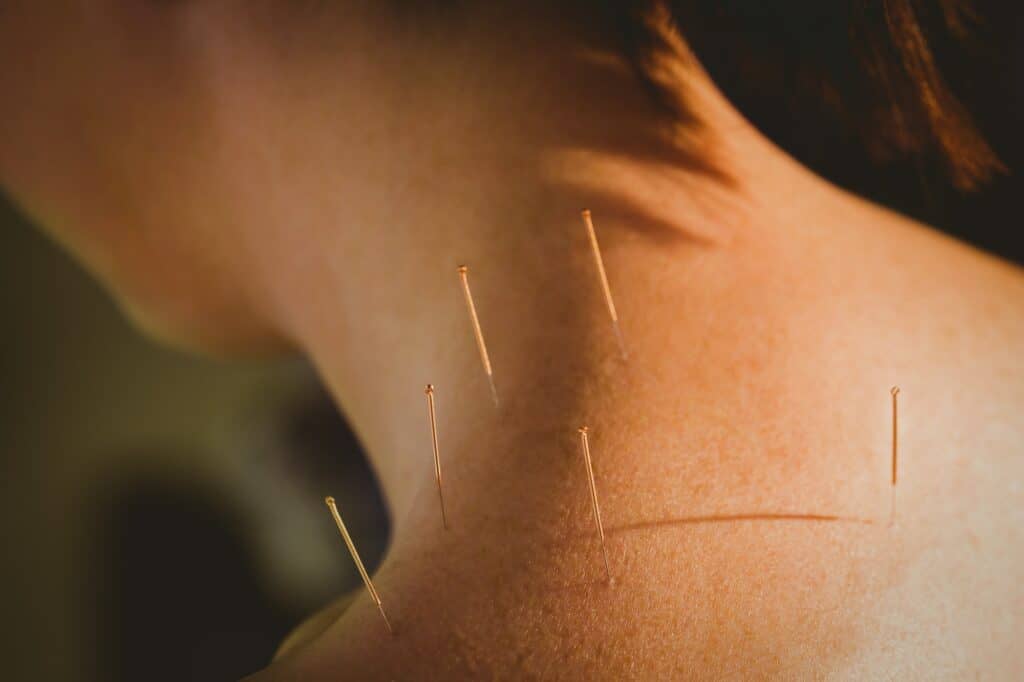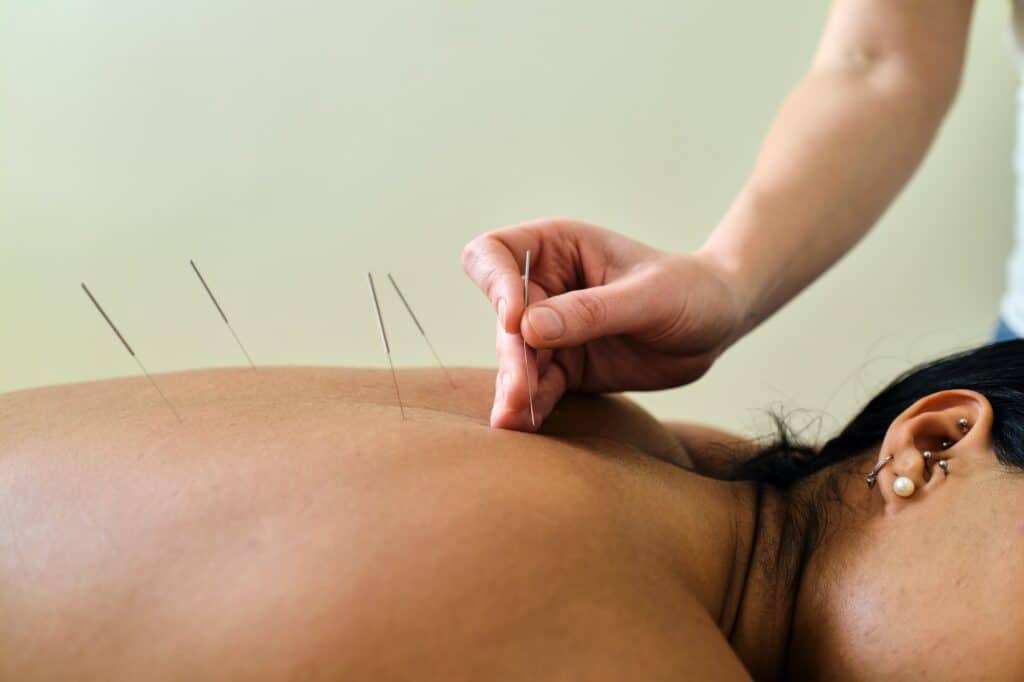Dry Needling Vs. Acupuncture: Which Is Right For You?
Are you seeking alternative therapies to manage your pain or enhance your overall well-being? Dry needling and acupuncture have gained considerable attention in recent years as effective treatments for various conditions. While both involve the insertion of thin needles into specific points on the body, these practices have fundamental differences. This blog post will delve into dry needling vs. acupuncture, exploring their unique techniques, origins, treatment goals, and more. By the end, you’ll have a clearer understanding of these therapies, allowing you to decide which approach may be right for you.
About Dry Needling
Dry needling is a therapeutic technique from Western medicine, utilizing thin needles to target muscle knots or trigger points. Drawing inspiration from acupuncture, it aims to alleviate pain, reduce pain, and restore normal muscle function, making it popular for musculoskeletal disorders and sports injuries.
Techniques and Tools Used in Dry Needling
Dry needling employs specific techniques and tools to target trigger points and alleviate pain and muscle dysfunction effectively. Here are some commonly used methods and tools in dry needling:
- Needle Insertion: Dry needling uses stainless steel needles, similar to acupuncture needles, for direct injection into trigger points or tight muscles, guided by palpation or ultrasound imaging.
- Trigger Point Identification: The practitioner identifies trigger points and hypersensitive muscle areas causing pain or dysfunction, using palpation techniques to locate them.
- Needle Manipulation: The practitioner inserts a needle into the trigger point and performs techniques like manual or electrical stimulation to elicit muscle response, enhancing the therapeutic effect.
- Local Twitch Response: Dry needling involves a local twitch response, believed to release tension and improve muscle function.
- Needle Retention: Needle retention occurs after eliciting a twitch response and addressing the trigger point, varying based on individual response and treatment goals.
Target Areas and Conditions Treated with Dry Needling
Dry needling is a versatile therapeutic technique that can address various musculoskeletal conditions. Here are some common target areas and conditions that can be adequately treated with dry needling:
- Neck and Shoulder Pain: Dry needling targets neck and shoulder muscles, relieving tension headaches and injuries.
- Back Pain: Lower back muscles develop trigger points, causing chronic pain; dry needling alleviates discomfort from conditions like lumbar strain, sciatica, and degenerative disc disease.
- Hip and Gluteal Pain: Dry needling addresses trigger points in the hip and gluteal muscles for piriformis syndrome.
- Knee Pain: Dry needling targets trigger points in the quadriceps, hamstrings, and calf muscles to relieve knee pain.
- Sports Injuries: Dry needling manages sports-related injuries, reducing pain, promoting healing, and restoring function.
- Fibromyalgia and Myofascial Pain Syndrome: Dry needling effectively treats fibromyalgia and myofascial pain by targeting trigger points and releasing muscle tension.
- Chronic Pain Conditions: Dry needling effectively manages chronic pain, modulating pain signals, promoting healing, and improving functional outcomes.
Exploring Acupuncture
Acupuncture, a therapeutic practice from ancient China, involves tiny needle placement into acupuncture points or meridians to balance vital energy flow. With over 2,000 years of history, it has evolved and gained popularity worldwide for its potential to promote health, alleviate pain, and restore balance.
The Traditional Chinese Medicine Principles Behind Acupuncture
The Traditional Chinese Medicine (TCM) principles behind acupuncture are founded on a comprehensive comprehension of the human body and its relationship to nature. These principles provide a framework for understanding health, disease, and the therapeutic effects of acupuncture. Here are the fundamental TCM principles that underpin acupuncture:
- Qi (Vital Energy): Qi, the fundamental life force, maintains health and vitality through meridians in Traditional Chinese Medicine (TCM) and promotes optimal health through acupuncture.
- Yin and Yang: Yin and Yang are complementary forces, with TCM focusing on health balance. Acupuncture aims to restore Yin-Yang balance by influencing Qi flow. Imbalances can lead to disease.
- Meridians and Acupuncture Points: Meridians are Qi-flowing pathways connecting acupuncture points with unique properties and functions. Stimulating these points with needles is believed to regulate Qi flow and restore balance.
- Five Elements Theory: TCM uses the Five Elements theory to understand body-environment relationships, guiding acupuncture treatment and assessing imbalances in organs, meridians, seasons, and emotions.
- Diagnostic Methods: TCM uses diagnostic methods like observation, palpation, questioning, and listening and smelling to assess health and identify disharmony patterns, enabling acupuncturists to develop personalized treatment plans.
Target Areas and Conditions Treated with Acupuncture
Acupuncture is a versatile therapeutic approach that can address many conditions. While the specific treatment plan should be tailored to the individual’s unique needs and assessment by a qualified acupuncturist, here are some common target areas and conditions that can be effectively treated with acupuncture:
- Musculoskeletal Conditions: Acupuncture alleviates pain and promotes healing in musculoskeletal conditions, reducing inflammation, relaxing muscles, improving circulation, and restoring function.
- Headaches and Migraines: Acupuncture effectively reduces headaches and migraines by easing pain and muscle tension and regulating brain flow.
- Stress, Anxiety, and Depression: Acupuncture improves relaxation, stress reduction, mental well-being, and neurotransmitter balance.
- Digestive Disorders: Acupuncture manages digestive disorders like IBS, acid reflux, bloating, constipation, and nausea, promoting balance.
- Women’s Health Issues: Acupuncture addresses concerns like menstrual irregularities, PMS, fertility, and hormonal imbalances, improving blood flow and reproductive health.
- Respiratory Conditions: Acupuncture aids in managing respiratory conditions, reducing inflammation, and improving lung function and immune response.
- Insomnia and Sleep Disorders: Acupuncture improves sleep quality by promoting relaxation, balancing energy, and addressing imbalances.

Dry Needling Vs. Acupuncture
Dry needling and acupuncture are two therapeutic techniques that involve needles, but they differ in their approaches and origins. Dry needling is a modern treatment technique primarily addressing musculoskeletal conditions and trigger points. It involves inserting thin needles directly into tight knots or trigger points in muscles, tendons, or fascia to relieve pain and improve mobility. Dry needling aims to stimulate a local twitch response, which can help release tension and promote healing in the affected area.
Acupuncture, a traditional Chinese medicine practice, balances the body’s energy or Qi by inserting needles into specific points along the meridian pathways. It restores Qi flow, harmonizes Yin and Yang, and addresses underlying patterns of disharmony. Acupuncture treats various conditions beyond musculoskeletal issues, such as stress, digestive disorders, and women’s health concerns. The choice between dry needling and acupuncture depends on the individual’s needs and condition. Consult a qualified practitioner to determine the most appropriate approach for your situation.
Choosing the Right Therapy for You: Dry Needling Vs. Acupuncture
When considering whether dry needling vs. acupuncture is the right therapy for you, assessing your specific needs, goals, and the nature of your condition is essential. Here are some factors to consider when making your decision:
- Condition or Symptoms: Assess the situation and symptoms: dry needling for musculoskeletal issues, while acupuncture is for broader concerns like pain management, stress, digestion, women’s health, and emotional well-being.
- Treatment Philosophy: Consider your preference for dry needling, a Western-based approach focusing on muscle manipulation, or acupuncture, a holistic approach balancing energy and addressing health issues.
- Professional Expertise: Choose a licensed practitioner with expertise in dry needling and acupuncture, ensuring they have specific training and certification and are experienced in Traditional Chinese Medicine and acupuncture.
- Individualized Approach: Consider individualized care levels in dry needling and acupuncture for tailored treatment plans, with acupuncture offering a holistic evaluation of health and well-being.
- Accessibility and Availability: Assess accessibility, availability, reputable practitioners, cost, insurance coverage, and scheduling convenience for nearby therapies to meet practical needs.
Possible Risks and Side Effects of Dry Needling and Acupuncture
Like any medical or therapeutic intervention, dry needling and acupuncture carry risks and potential side effects. It’s essential to be aware of these before undergoing treatment. Here are some possible risks and side effects associated with each therapy:
Dry Needling:
- Soreness or Discomfort: Dry needling causes mild, short-lived soreness at needle insertion sites.
- Bruising or Bleeding: Bleeding or minor bleeding may occur at needle insertion sites.
- Fatigue or Dizziness: Dry needling may cause temporary fatigue or dizziness; rest and avoid strenuous activities.
- Risk of Infection: Adhere to proper hygiene and sterilization for needle insertion to prevent infection.
- Pneumothorax (Rare): Improper needling technique can cause lung collapse; skilled practitioners minimize risk through anatomy knowledge and guidelines.
Acupuncture:
- Soreness or Discomfort: Some may experience temporary discomfort at acupuncture points after treatment.
- Bruising or Minor Bleeding: Acupuncture needle insertion sites may cause minor bruising or bleeding, especially for sensitive skin or blood-thinning medications.
- Fatigue or Drowsiness: Acupuncture treatments may cause temporary fatigue and drowsiness; avoid heavy machinery or driving.
- Emotional Release: Acupuncture can induce emotional release during healing, releasing stored emotions or energetic blockages.
- Infection and Contamination: Use sterile, single-use needles to minimize infection risk with proper sterilization and hygiene.
When considering whether dry needling vs. acupuncture is the right therapy for you, assessing your specific needs, treatment goals, and personal preferences is crucial. Both therapies offer unique benefits and can address various conditions, but their underlying principles and treatment approaches differ. Remember to consult with qualified practitioners who can provide expert guidance based on your needs. Don’t hesitate to contact us today if you have further questions or want to explore your options. Contact us via email at info@activemedhealth.com, and our knowledgeable team will gladly assist you on your way to improved health and happiness.




